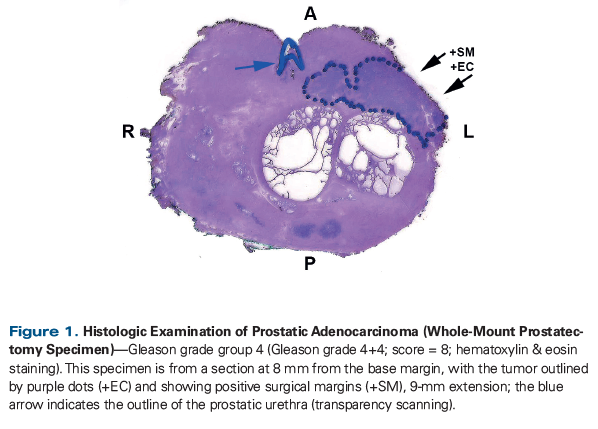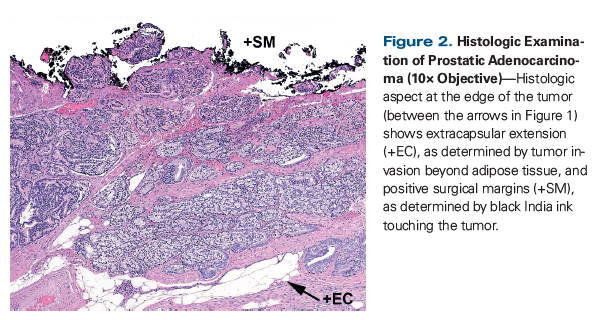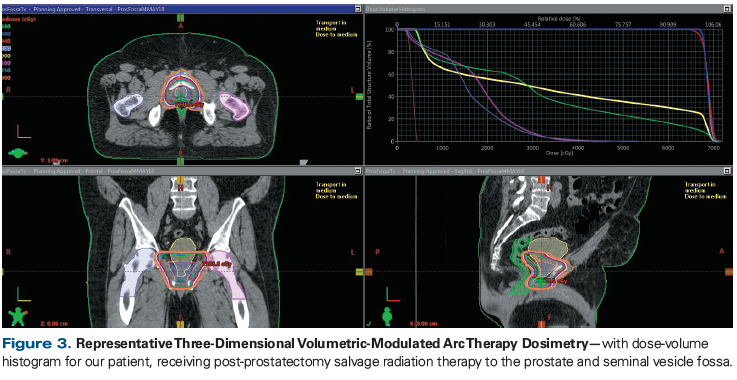The Case
A 62-year-old man with American Joint Committee on Cancer (AJCC) 8th Edition clinical stage IIC (cT2aN0M0), Gleason grade group 3 (4 + 3) prostate adenocarcinoma, with a pretreatment prostate-specific antigen (PSA) level of 15.6 ng/mL, elected to proceed with radical prostatectomy as definitive management. The final pathology report showed extracapsular extension (pT3a), negative pelvic lymph nodes (pN0), positive surgical margins (Figures 1 and 2), Gleason grade group 4 (4 + 4), and an undetectable post-prostatectomy PSA level, which was classified as AJCC 8th Edition pathologic stage IIIB. The patient was referred to a radiation oncologist, and the existing randomized data supporting adjuvant radiation therapy were reviewed. Further, GenomeDx’s Decipher test was performed and showed a high-risk score.
Management options, including adjuvant radiation therapy and close observation via serial biochemical testing, were discussed with the patient, who ultimately elected observation. Nine months after prostatectomy, ultrasensitive PSA testing showed a detectable level (0.03 ng/mL). PSA levels 6 weeks and 12 weeks later were 0.07 ng/mL and 0.18 ng/mL, respectively.
What is the most appropriate next step in the management of this patient?
A. Observation until his PSA level is > 0.2 ng/mL, then recommend salvage radiation therapy
B. Recommend salvage radiation therapy now, without androgen deprivation therapy (ADT)
C. Recommend salvage radiation therapy now and consider concurrent ADT
D. Proceed with prostate cancer–specific positron emission tomography (pcPET) imaging, followed by salvage radiation therapy if there is no evidence of metastatic disease
Correct Answer: C
Discussion
This case highlights several important issues in the management of post-prostatectomy patients with high-risk features. In this discussion, we will review the evidence for initiating adjuvant radiation therapy in patients with extracapsular extension, seminal vesicle invasion, and/or positive surgical margins, and address the controversy regarding early salvage radiation therapy as a substitute for adjuvant radiation therapy. Importantly, the tools available to prostate cancer physicians are increasing rapidly; here, we will review the value of genomic classifiers in adjuvant radiation therapy decision making. Further, we will discuss the role of next-generation prostate cancer–specific imaging in the context of salvage radiation therapy decision making.
Adjuvant vs early salvage radiation therapy
The American Urological Association (AUA)/American Society for Radiation Oncology (ASTRO) guideline statement on adjuvant and salvage radiotherapy after prostatectomy states that patients with adverse pathologic findings, including extracapsular extension, seminal vesicle invasion, and/or positive surgical margins, should be offered adjuvant radiation therapy.[1] These recommendations are based on the results of three randomized studies: Southwest Oncology Group (SWOG) 8794,[2,3] European Organisation for Research and Treatment of Cancer (EORTC) 22911,[4,5] and Arbeitsgemeinschaft Radiologische Onkologie (ARO) 96-02.[6,7] The 10-year follow-up results are available for both the ARO and EORTC studies, each demonstrating an improvement in biochemical progression–free survival, but not overall survival, with adjuvant radiation therapy.[5,6] The 15-year follow-up is available for the SWOG study, which showed that adjuvant radiation therapy reduced metastases and increased survival.[3] Further, these three studies serve as the basis for a Cochrane review published in 2011, which demonstrated an overall survival benefit at 10 years, with a number needed to treat (NNT) of 10.[8]
Despite these data and the AUA/ASTRO guideline statement in favor of adjuvant radiation therapy for high-risk features,[1] fewer than 10% of patients in the United States receive adjuvant radiation therapy in this setting.[9] Concerns about overtreatment and treatment toxicity are likely drivers behind this practice pattern. Relevant to these concerns, it should be mentioned that in the SWOG study (which utilized outdated radiation techniques by today’s standards), global health-related quality of life, while lower in the radiation arm initially, was actually higher than that seen in the observation arm at 5 years.[10]
Another likely contributor to the low rates of adjuvant radiation therapy delivery is the fact that, at present, there are no prospective randomized comparisons of adjuvant vs early salvage radiation therapy, although these studies are well underway (eg, RADICALS, ClinicalTrials.gov identifier: NCT00541047; GETUG-AFU 17, NCT00667069; and RAVES, NCT00860652). Of note, a large multi-institutional propensity score–matched cohort of 1,566 patients demonstrated an improvement in biochemical recurrence, distant metastases, and overall survival in the patients who received adjuvant vs early salvage radiation therapy.[11] Nevertheless, while these prospective randomized studies are very important, and we anxiously await the results, there is emerging evidence that suggests that genomic classifiers may serve as a more personalized tool to select patients for adjuvant radiation therapy.[12,13]
The value of genomic classifiers
Our patient underwent Decipher testing, which contributed to our recommendation for adjuvant radiation therapy (although he ultimately declined). Decipher is a 22-gene expression array that is predictive for the development of metastases after radical prostatectomy.[13] Den et al demonstrated that for patients with high Decipher scores, the 5-year incidence of metastases was significantly lower in the patients who received adjuvant radiation compared with those who received salvage radiation. There was no difference in the incidence of metastases between patients with low Decipher scores who received adjuvant vs salvage radiation.[13]
Dalela et al built on these findings and developed a nomogram incorporating the Decipher score to help tailor recommendations to a patient’s specific risk factors.[12] In their model, risk factors included pT3b/T4 disease, pathologic Gleason score > 8, lymph node invasion, and a high Decipher score. In patients with two or more risk factors, the NNT with adjuvant radiation therapy to prevent one clinical recurrence was 3.1.[12] The use of genomic classifiers, such as Decipher, should be considered to help navigate post-prostatectomy decision making. Based on these data, our patient was very likely to benefit from adjuvant radiation therapy. However, despite this recommendation, he declined adjuvant therapy and is now presenting with a rising PSA level.
Is next-generation imaging at odds with early salvage radiation?
Historically, rates of successful salvage have been disappointing.[14] Contemporary tools such as ultrasensitive PSA testing and next-generation imaging can help further individualize therapy to better select patients likely to benefit from salvage radiation. However, at present, determining how best to use these tools together remains challenging, and one might argue that next-generation imaging is even in conflict with the goal of early salvage radiation. One reason for the historically low rates of successful salvage is that, in a proportion of patients, a rising PSA level is due to early metastatic disease rather than a prostate bed recurrence.
Conventional prostate cancer imaging techniques (CT and technetium [99mTc] medronic acid [MDP] bone scan) have a low sensitivity for the detection of lymph node or bone metastases unless PSA levels are very high,[15] and therefore are of little use in ruling out metastatic prostate cancer when the patient has low PSA levels. On the other hand, next-generation imaging, specifically pcPET, can detect prostate cancer recurrences at low PSA levels.[16] Although these technologies are likely to drastically reshape the landscape of prostate cancer management, at present it is unclear how to use these tools in a patient such as the one described here. The current pcPET imaging platforms include C-11/F-18 choline; gallium 68/F-18 prostate-specific membrane antigen (PSMA); and the US Food and Drug Administration–approved Axumin, also known as F-18 anti-1-amino-3-[18F]fluorocyclobutane-1- carboxylic acid (FACBC). A recent comprehensive review of existing studies reported that the sensitivity of PSMA at a PSA level < 1.0 ng/mL, 1.0–2.0 ng/mL, and > 2.0 ng/mL, was 51.5%, 74.0%, and 90.5%, respectively.[16] The sensitivity of the Axumin scan at a PSA level < 1.0 ng/mL, 1.0–2.0 ng/mL, and > 2.0 ng/mL, was 38%, 65%, and 78%, respectively.[16] The sensitivity of the choline scan at a PSA level < 1.0 ng/mL, 1.0–2.0 ng/mL, and > 2.0 ng/mL, was 19.5%, 44.5%, and 76.0%, respectively.[16]
Although the pcPET modalities are significantly more adept at showing prostate cancer recurrences compared with conventional imaging techniques, the optimal PSA range for these modalities is above the PSA range at which salvage radiation therapy should be initiated for the highest likelihood of success. Salvage radiation is most successful in patients with pre-salvage PSA levels < 0.50 ng/mL,[14,17] with data to support that the best outcomes are seen in patients with pre-salvage PSA levels < 0.20 ng/mL.[18] In the updated multi-institutional salvage radiotherapy nomogram from Tendulkar et al, the 5-year rates of freedom from biochemical progression were 71%, 63%, 54%, 43%, and 37%, for patients with pre-salvage PSA levels of 0.01–0.2 ng/mL, 0.21–0.50 ng/mL, 0.51–1.0 ng/mL, 1.01–2.0 ng/mL, and > 2.0 ng/mL, respectively.[18]
Therefore, for a patient such as ours, with risk factors for prostate bed recurrence (ie, positive surgical margins in our patient), who is presenting with a very low (below the sensitivity of pcPET) but detectable and rising PSA, we do suggest proceeding with salvage radiation therapy without first obtaining pcPET. However, for patients with PSA levels that would suggest a reasonable likelihood of detecting recurrence on pcPET, with a pretest sensitivity that appears to rise above 50% with PSA absolute values exceeding 0.5 ng/mL, it would seem appropriate to consider pcPET to evaluate for distant metastatic disease or a gross prostate bed recurrence prior to proceeding with salvage radiation therapy, since these findings might alter management. The impact of advanced PET imaging on medical decision making and disease outcomes in the setting of biochemically recurrent prostate cancer requires further investigation.
Salvage radiation therapy target volumes, dose, and the benefit of ADT
Again, for our patient, we would recommend proceeding directly to salvage radiation therapy. In our practice, the target volume for salvage radiation therapy includes the prostate and seminal vesicle fossa, which is treated to a dose of 66 Gy with conventional fractionation, using volumetric-modulated arc therapy with daily cone beam CT for image guidance (Figure 3). Importantly, moderately hypofractionated post-prostatectomy radiation is currently being compared with conventionally fractionated post-prostatectomy radiation in NRG Oncology’s NRG-GU003 trial (ClinicalTrials.gov identifier: NCT03274687).
Consideration can be given to electively treating the regional lymph nodes as well, though most of the prospective trials using postoperative radiation therapy have not done so. The role of pelvic lymph node radiation for intact prostate cancer has long been an area of considerable debate. The existing prospective randomized trials fail to provide convincing evidence of a benefit from pelvic lymph node radiation.[19,20] However, both of these studies have been criticized for flaws in their design, and this question is currently being addressed again in Radiation Therapy Oncology Group (RTOG) 0924 (ClinicalTrials.gov identifier: NCT01368588). Meanwhile, there are no prospective randomized trials reporting on pelvic lymph node vs prostate bed–only target volumes in salvage radiation therapy, although this is currently being addressed in RTOG 0534 (ClinicalTrials.gov identifier: NCT00567580).
KEY POINTS
- Postoperative radiation therapy improves oncologic outcome in select men undergoing radical prostatectomy with high-risk features for postsurgical recurrence.
- Ultra-sensitive prostate-specific antigen (PSA) assays, genomic classifiers, and novel imaging tools may improve risk stratification, enhance patient selection for postoperative therapy, and improve postoperative radiation therapy targeting.
- In men with persistent or rising PSA levels following prostatectomy, the addition of androgen deprivation therapy to salvage radiation therapy improves the likelihood of successful salvage and fosters superior cancer-related outcomes compared with radiation therapy alone.
Importantly, two large multi-institutional prospective randomized controlled trials addressing the role of ADT in salvage radiation have been published in recent years: RTOG 9601 and GETUG-AFU 16.[21,22] Notably, elective nodal irradiation was not allowed in either of these studies, further supporting the omission of elective nodal irradiation in the salvage setting. These studies are the basis for our recommendation to consider ADT with salvage prostate radiation therapy in our patient (Answer C). RTOG 9601 randomized patients after radical prostatectomy with PSA levels 0.2 to 4.0 ng/mL to salvage radiation therapy with 24 months of concurrent and adjuvant bicalutamide or placebo. At 12-year follow-up, improved overall and prostate cancer–specific survival and a reduction in the incidence of metastases were demonstrated in the bicalutamide arm.[21] Similarly, GETUG-AFU 16 randomized patients after radical prostatectomy with PSA levels of 0.2 to 2.0 ng/mL to salvage radiation therapy with or without 6 months of concurrent and adjuvant goserelin acetate, and demonstrated improved freedom from biochemical and clinical progression at 5 years.[22]
In our practice, we use short-term (~6 months) neoadjuvant and concurrent luteinizing hormone-releasing hormone agonist therapy with salvage radiation. Importantly, neither RTOG 9601 nor GETUG-AFU 16 enrolled patients with pre-salvage PSA levels < 0.2 ng/mL.[21,22] Further, post-hoc analysis of RTOG 9601 failed to show a benefit from the addition of ADT for patients with pre-salvage PSA levels < 0.7 ng/mL.[21] However, the benefit from ADT that was observed in GETUG-AFU 16 did persist for patients with pre-salvage PSA levels < 0.5 ng/mL compared with patients with pre-salvage PSA levels > 0.5 ng/mL.[22] Therefore, although we do recommend ADT with salvage radiation for patients with PSA levels < 0.7 ng/mL, our recommendation is not as strong as it is for patients with PSA levels > 0.7 ng/mL, and we will support omission of ADT in these patients if they are opposed to hormone therapy.
Summary
In recent years, the therapeutic and diagnostic tools in prostate cancer, as well as the data available to guide post-prostatectomy decision making and improve salvage radiation therapy outcomes, have evolved substantially. Genomic classifiers can be used to help improve the therapeutic ratio in adjuvant radiation therapy.[12,13] Ultrasensitive PSA testing allows for salvage radiation therapy to be initiated earlier, which, in large multi-institutional datasets, is associated with improved outcomes.[14,17,18] Further, pcPET may be useful in patients with biochemically recurrent or persistent prostate cancer following prostatectomy, although salvage radiation therapy should not be withheld while waiting for PSA levels to reach the range that is appropriate for these imaging modalities. Finally, prospective randomized data support the use of ADT with salvage radiation to further improve outcomes for these patients.
Financial Disclosure:The authors have no significant financial interest in or other relationship with the manufacturer of any product or provider of any service mentioned in this article.
References:
1. Thompson IM, Valicenti RK, Albertsen P, et al. Adjuvant and salvage radiotherapy after prostatectomy: AUA/ASTRO Guideline. J Urol. 2013;190:441-9.
2. Thompson IM, Tangen CM, Paradelo J, et al. Adjuvant radiotherapy for pathologically advanced prostate cancer: a randomized clinical trial. JAMA. 2006;296:2329-35.
3. Thompson IM, Tangen CM, Paradelo J, et al. Adjuvant radiotherapy for pathological T3N0M0 prostate cancer significantly reduces risk of metastases and improves survival: long-term follow-up of a randomized clinical trial. J Urol. 2009;181:956-62.
4. Bolla M, van Poppel H, Collette L, et al. Postoperative radiotherapy after radical prostatectomy: a randomised controlled trial (EORTC trial 22911). Lancet. 2005;366:572-8.
5. Bolla M, van Poppel H, Tombal B, et al. Postoperative radiotherapy after radical prostatectomy for high-risk prostate cancer: long-term results of a randomised controlled trial (EORTC trial 22911). Lancet. 2012;380:2018-27.
6. Wiegel T, Bartkowiak D, Bottke D, et al. Adjuvant radiotherapy versus wait-and-see after radical prostatectomy: 10-year follow-up of the ARO 96-02/AUO AP 09/95 trial. Eur Urol. 2014;66:243-50.
7. Wiegel T, Bottke D, Steiner U, et al. Phase III postoperative adjuvant radiotherapy after radical prostatectomy compared with radical prostatectomy alone in pT3 prostate cancer with postoperative undetectable prostate-specific antigen: ARO 96-02/AUO AP 09/95. J Clin Oncol. 2009;27:2924-30.
8. Daly T, Hickey BE, Lehman M, et al. Adjuvant radiotherapy following radical prostatectomy for prostate cancer. Cochrane Database Syst Rev. 2011;CD007234.
9. Sineshaw HM, Gray PJ, Efstathiou JA, Jemal A. Declining use of radiotherapy for adverse features after radical prostatectomy: results from the National Cancer Data Base. Eur Urol. 2015;68:768-74.
10. Moinpour CM, Hayden KA, Unger JM, et al. Health-related quality of life results in pathologic stage C prostate cancer from a Southwest Oncology Group trial comparing radical prostatectomy alone with radical prostatectomy plus radiation therapy. J Clin Oncol. 2008;26:112-20.
11. Hwang WL, Tendulkar RD, Niemierko A, et al. Comparison between adjuvant and early-salvage postprostatectomy radiotherapy for prostate cancer with adverse pathological features. JAMA Oncol. 2018;4:e175230.
12. Dalela D, Santiago-Jimenez M, Yousefi K, et al. Genomic classifier augments the role of pathological features in identifying optimal candidates for adjuvant radiation therapy in patients with prostate cancer: development and internal validation of a multivariable prognostic model. J Clin Oncol. 2017;35:1982-90.
13. Den RB, Yousefi K, Trabulsi EJ, et al. Genomic classifier identifies men with adverse pathology after radical prostatectomy who benefit from adjuvant radiation therapy. J Clin Oncol. 2015;33:944-51.
14. Stephenson AJ, Scardino PT, Kattan MW, et al. Predicting the outcome of salvage radiation therapy for recurrent prostate cancer after radical prostatectomy. J Clin Oncol. 2007;25:2035-41.
15. Abuzallouf S, Dayes I, Lukka H. Baseline staging of newly diagnosed prostate cancer: a summary of the literature. J Urol. 2004;171:2122-7.
16. Evans JD, Jethwa KR, Ost P, et al. Prostate cancer-specific PET radiotracers: a review on the clinical utility in recurrent disease. Pract Radiat Oncol. 2018;8:28-39.
17. Stish BJ, Pisansky TM, Harmsen WS, et al. Improved metastasis-free and survival outcomes with early salvage radiotherapy in men with detectable prostate-specific antigen after prostatectomy for prostate cancer. J Clin Oncol. 2016;34:3864-71.
18. Tendulkar RD, Agrawal S, Gao T, et al. Contemporary update of a multi-institutional predictive nomogram for salvage radiotherapy after radical prostatectomy. J Clin Oncol. 2016;30:3648-54.
19. Lawton CA, DeSilvio M, Roach M 3rd, et al. An update of the phase III trial comparing whole pelvic to prostate only radiotherapy and neoadjuvant to adjuvant total androgen suppression: updated analysis of RTOG 94-13, with emphasis on unexpected hormone/radiation interactions. Int J Radiat Oncol Biol Phys. 2007;69:646-55.
20. Roach M 3rd, DeSilvio M, Valicenti R, et al. Whole-pelvis, “mini-pelvis,” or prostate-only external beam radiotherapy after neoadjuvant and concurrent hormonal therapy in patients treated in the Radiation Therapy Oncology Group 9413 trial. Int J Radiat Oncol Biol Phys. 2006;66:647-53.
21. Shipley WU, Seiferheld W, Lukka HR, et al. Radiation with or without antiandrogen therapy in recurrent prostate cancer. N Engl J Med. 2017;376:417-28.
22. Carrie C, Hasbini A, de Laroche G, et al. Salvage radiotherapy with or without short-term hormone therapy for rising prostate-specific antigen concentration after radical prostatectomy (GETUG-AFU 16): a randomised, multicentre, open-label phase 3 trial. Lancet Oncol. 2016;17:747-56.



